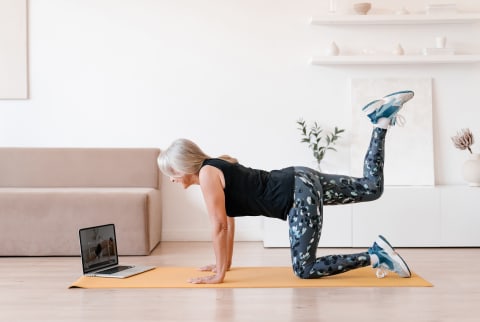Advertisement
What Women Need To Know About Zone 2 & The Best Exercise Post-Menopause


Workout fads are inherently problematic, as they miss a huge part of the equation: Not every person will reap the same benefits from any given exercise—be it daily HIIT, Pilates, long-distance running, or weight training.
In fact, according to exercise physiologist and nutrition scientist Stacy Sims, Ph.D., these needs differ greatly between men and women, especially when it comes to zone 2 cardio training.
She dives into these nuances on this episode of the mindbodygreen podcast, but here's a summary of her take on the best workout method for women—and how it should change with age.
What women need to know about zone 2 training
First, let's talk about zone 2 training. In case you need a refresher, zone 2 cardio is an exercise performed within a heart rate zone that represents 60% to 70% of the maximum heart rate. Think of it as light exercise that you can continue for a prolonged period of time—jogging, brisk walking, swimming, etc.
Research has shown great health benefits from this cardio, including weight loss and mitochondrial health; however, Sims says this research is flawed: "The conversation around zone 2 is all based on male physiology and data," she declares.
See, zone 2 training helps stimulate type 1 ("slow twitch") muscle fibers, which increase the mitochondrial density in our muscles. However, "Women already have a larger amount of slow twitch or oxidative fibers," Sims notes. "Women have more mitochondria density [and] better mitochondria respiration." She continues, "When we look at men, yes, they need to do zone 2 to increase mitochondrial density and the respiratory capacity of mitochondria, but women don't."
Let's be clear: Zone 2 exercise is not necessarily bad for women—the best exercise is the one you'll actually do, after all. Zone 2 is great for active recovery and endurance, but Sims argues it won't help women achieve every exercise goal.
Namely, if you're a woman seeking muscle gains or mitochondrial health, Sims argues zone 2 might not be the best approach. (You can dive into the research in Sims' comprehensive blog post here.)
Rather, "Women need to do more of that high-intensity work," she explains. Think sprints and resistance training versus continuous, intermediate cardio. This way, your body will actually recognize your efforts, she says.
How to exercise after menopause
Once women hit menopause, though, things change. During the initial period after menopause hits—say, the first five or six years postmenopause—it's a good idea to stick with the high-intensity and weight training you were doing before menopause.
However, "Once we get to late postmenopause—that's six years onward—we see that [women] don't respond as well to the high-intensity work," Sims explains. "So, what we need to do is have more regular doses of high-intensity, more regular doses of resistance training, but less volume."
What does this look like? Well, rather than committing to two days of 30-minute sprint intervals, for example, you'll do four days of 15 minutes. Essentially, she suggests splitting up your exercise plan so you have more regular, but shorter, doses of that training. (She has another blog post on the matter here, if you'd like to check that out.)
She adds that you'll want to pay attention to protein during perimenopause and thereafter. Perimenopause1—the transition into menopause that starts as early as age 35 in some women—alters hormones and body composition in a way that may increase your protein requirements2.
TL;DR? Do your best to keep high-intensity training in your exercise repertoire after menopause, and begin to opt for shorter but more frequent doses of it once you enter late postmenopause, Sims says.
Again, it's important to remember that everyone's exercise needs are different. As Sims says, there is a significant lack of research on women's health, so lean into personalization and do what's best for you. Exercise, in general, is great for physical and mental health, so any type of movement is always better than none.
The takeaway
Zone 2 cardio does have some great health benefits, but it's not necessarily the best fit for women entering menopause. Instead, Sims recommends keeping high-intensity training in your exercise repertoire after menopause and opting for shorter, more frequent doses of it once you enter late postmenopause.
Want to dive even deeper into women's health, protein needs, and cardio training? Simply tune into Sims' episode below: